跨文化商务沟通の课件总结
- 格式:doc
- 大小:175.00 KB
- 文档页数:13
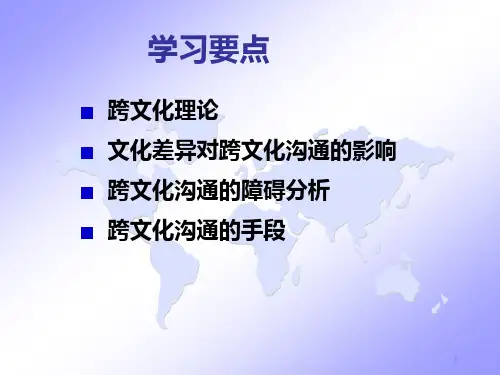

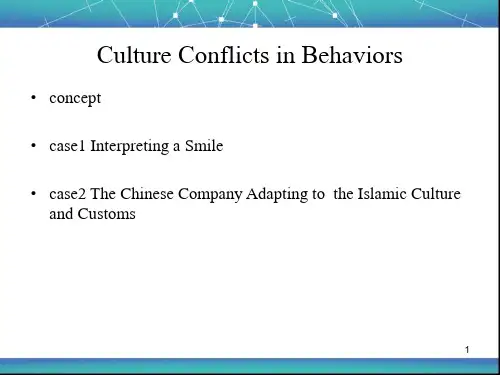

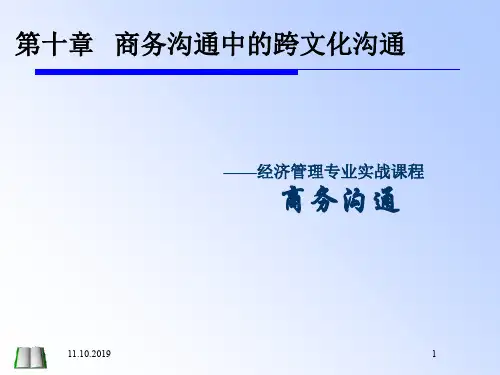
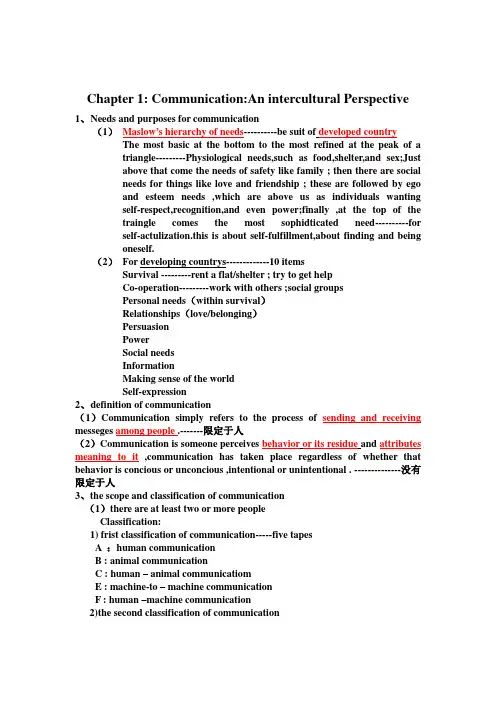
Chapter 1: Communication:An intercultural Perspective 1、N eeds and purposes for communication(1)Maslow’s hierarchy of needs----------be suit of developed country The most basic at the bottom to the most refined at the peak of atriangle---------Physiological needs,such as food,shelter,and sex;Justabove that come the needs of safety like family ; then there are socialneeds for things like love and friendship ; these are followed by egoand esteem needs ,which are above us as individuals wantingself-respect,recognition,and even power;finally ,at the top of thetraingle comes the most sophidticated need----------forself-actulization.this is about self-fulfillment,about finding and beingoneself.(2)For developing countrys-------------10 itemsSurvival ---------rent a flat/shelter ; try to get helpCo-operation---------work with others ;social groupsPersonal needs(within survival)Relationships(love/belonging)PersuasionPowerSocial needsInformationMaking sense of the worldSelf-expression2、d efinition of communication(1)Communication simply refers to the process of sending and receiving messeges among people .-------限定于人(2)Communication is someone perceives behavior or its residue and attributes meaning to it,communication has taken place regardless of whether that behavior is concious or unconcious ,intentional or unintentional . --------------没有限定于人3、the scope and classification of communication(1)there are at least two or more peopleClassification:1) frist classification of communication-----five tapesA :human communicationB : animal communicationC : human – animal communicatiomE : machine-to – machine communicationF : human –machine communication2)the second classification of communication(2)There must be some contact between communicators.(3)There must to be a language shared by communicators.(4)An exchange of information has taken placeThere is often taken as a successful condition of communication .but there are various degrees of success in communication,ranging from complete success,partial success to failure.4、T he process of communicationa)components of communicationThe definition identifies eight key components of communicationwithin the framework of intentional communication:message, ,sender , receiver ,channel , noise , feedback,encoding and decoding.i.messege--------verbal and nonverbal--------carries ideas from oneperson to another.2)sender refers to the person who sends the message .While the receiveris the one who receiver the message. :in order to reduce the uncertaintyor misunderstandings,the sender should think from the receiver’s piontof view when composing the message ,Besides ,the role of sender andreceiver is always changing.3)Channel/Medium refers to the way for sending or receiving message.4)Niose refers to the disturbances along the communicationprocesses ,which may resultunintended message perceived by therecevier .such as environment5)Feedback refers to the reaction from the message receiver to themessage sender.6)Encoding refers to the reaction from the message into asignal;Decoding refers to the process of the receiver interpreting thesignal from the senger.Encoding:the process of collecting message,considered of socialhabits,culture,communications rule.Decoding :the process of collecting feedback.b) Models of communication1. The Linear Model (线性模型)What it basically says is 5Ws:Who A senderSay what Directs a MessageIn which channel Through some MediumTo whom To a receiverAnd with what effect With some effectWhat sender through what message through what channel to whatreceiver with what effectThe theory’s advantages and disadvantagesAdvantages:this is a vary popular model which has been usedby a lot of communication scholars(this is the earlest andstill most useful method);Disadvantage:①human communication involves many morethings. e.g:power relations,rolerelations.age and sex difference,feelings②there are no feesback in this model(itdon’t pay attention to the feedback.).2.The Circular Model(环形模型)The communication is two-way process and thar everyone is both a decoder and an encoder.This model focus on feedback.3)The Contextualized ModelContext refers to the idea that every act of communication must been happen in some sort of surroundings,and what it meant by this is actually quite complicated。

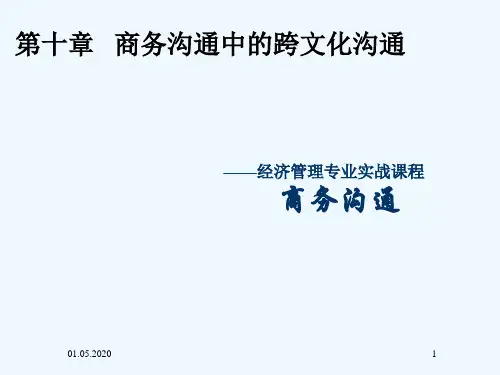
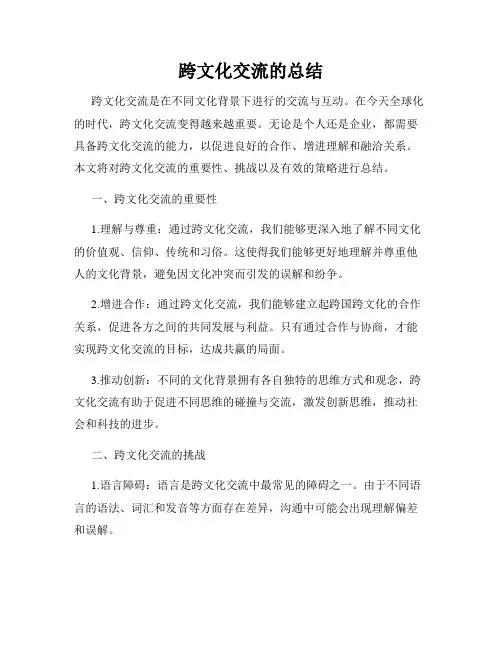
跨文化交流的总结跨文化交流是在不同文化背景下进行的交流与互动。
在今天全球化的时代,跨文化交流变得越来越重要。
无论是个人还是企业,都需要具备跨文化交流的能力,以促进良好的合作、增进理解和融洽关系。
本文将对跨文化交流的重要性、挑战以及有效的策略进行总结。
一、跨文化交流的重要性1.理解与尊重:通过跨文化交流,我们能够更深入地了解不同文化的价值观、信仰、传统和习俗。
这使得我们能够更好地理解并尊重他人的文化背景,避免因文化冲突而引发的误解和纷争。
2.增进合作:通过跨文化交流,我们能够建立起跨国跨文化的合作关系,促进各方之间的共同发展与利益。
只有通过合作与协商,才能实现跨文化交流的目标,达成共赢的局面。
3.推动创新:不同的文化背景拥有各自独特的思维方式和观念,跨文化交流有助于促进不同思维的碰撞与交流,激发创新思维,推动社会和科技的进步。
二、跨文化交流的挑战1.语言障碍:语言是跨文化交流中最常见的障碍之一。
由于不同语言的语法、词汇和发音等方面存在差异,沟通中可能会出现理解偏差和误解。
2.文化差异:文化差异是导致跨文化交流困难的主要原因之一。
在不同文化间,礼仪、信仰、价值观等方面的差异可能导致误解和冲突。
3.沟通方式:不同文化间的沟通方式和风格可能存在差异,如直接与间接沟通、面对面交流与书面沟通等。
这些差异可能影响信息的传递和理解。
4.偏见和刻板印象:由于对他人文化的陌生和不理解,我们可能会产生偏见和刻板印象。
这种偏见可能会阻碍跨文化交流的顺利进行。
三、有效的跨文化交流策略1.培养文化敏感度:了解他人的文化,包括价值观、行为规范和社会习俗等,以增强对文化差异的认识和理解。
这有助于在跨文化环境中更加敏感地处理问题和与他人合作。
2.学习对方语言:学习对方的语言可以缓解语言障碍,提升交流效果。
尽管不一定要精通对方语言,但具备一些基本的交流能力是非常有帮助的。
3.尊重和包容:尊重他人的文化差异是建立良好跨文化关系的基础。


Chapter 1: Communication:An intercultural Perspective 1、N eeds and purposes for communication(1)Maslow’s hierarchy of needs----------be suit of developed country The most basic at the bottom to the most refined at the peak of atriangle---------Physiological needs,such as food,shelter,and sex;Justabove that come the needs of safety like family ; then there are socialneeds for things like love and friendship ; these are followed by egoand esteem needs ,which are above us as individuals wantingself-respect,recognition,and even power;finally ,at the top of thetraingle comes the most sophidticated need----------forself-actulization.this is about self-fulfillment,about finding and beingoneself.(2)For developing countrys-------------10 itemsSurvival ---------rent a flat/shelter ; try to get helpCo-operation---------work with others ;social groupsPersonal needs(within survival)Relationships(love/belonging)PersuasionPowerSocial needsInformationMaking sense of the worldSelf-expression2、d efinition of communication(1)Communication simply refers to the process of sending and receiving messeges among people .-------限定于人(2)Communication is someone perceives behavior or its residue and attributes meaning to it,communication has taken place regardless of whether that behavior is concious or unconcious ,intentional or unintentional . --------------没有限定于人3、the scope and classification of communication(1)there are at least two or more peopleClassification:1) frist classification of communication-----five tapesA :human communicationB : animal communicationC : human – animal communicatiomE : machine-to – machine communicationF : human –machine communication2)the second classification of communication(2)There must be some contact between communicators.(3)There must to be a language shared by communicators.(4)An exchange of information has taken placeThere is often taken as a successful condition of communication .but there are various degrees of success in communication,ranging from complete success,partial success to failure.4、T he process of communicationa)components of communicationThe definition identifies eight key components of communicationwithin the framework of intentional communication:message, ,sender , receiver ,channel , noise , feedback,encoding and decoding.i.messege--------verbal and nonverbal--------carries ideas from oneperson to another.2)sender refers to the person who sends the message .While the receiveris the one who receiver the message. :in order to reduce the uncertaintyor misunderstandings,the sender should think from the receiver’s piontof view when composing the message ,Besides ,the role of sender andreceiver is always changing.3)Channel/Medium refers to the way for sending or receiving message.4)Niose refers to the disturbances along the communicationprocesses ,which may resultunintended message perceived by therecevier .such as environment5)Feedback refers to the reaction from the message receiver to themessage sender.6)Encoding refers to the reaction from the message into asignal;Decoding refers to the process of the receiver interpreting thesignal from the senger.Encoding:the process of collecting message,considered of socialhabits,culture,communications rule.Decoding :the process of collecting feedback.b) Models of communication1. The Linear Model (线性模型)What it basically says is 5Ws:Who A senderSay what Directs a MessageIn which channel Through some MediumTo whom To a receiverAnd with what effect With some effectWhat sender through what message through what channel to whatreceiver with what effectThe theory’s advantages and disadvantagesAdvantages:this is a vary popular model which has been usedby a lot of communication scholars(this is the earlest andstill most useful method);Disadvantage:①human communication involves many morethings. e.g:power relations,rolerelations.age and sex difference,feelings②there are no feesback in this model(itdon’t pay attention to the feedback.).2.The Circular Model(环形模型)The communication is two-way process and thar everyone is both a decoder and an encoder.This model focus on feedback.3)The Contextualized ModelContext refers to the idea that every act of communication must been happen in some sort of surroundings,and what it meant by this is actually quite complicated。
Most obviously there is the physical context------whether we are talking to someone in our living room or on the terraces at a football match.e.g.: room,street,hospital.Then there are is social context,which has to do with the occasion involved and the people in it. E.g:Then there is the culture context,which refers to an even broder set of circumstances and beliefs,which will affect how we communicate.5、C haracteristics of Communication(1)Communication is dynamic(2)Communication is irreversible(3)Communication is symbolic(4)Communication is systemic(5)Communication is self-reflective(6)Communication is interactive(7)Communication is complex6、I ntercultural communication(ICC)is simply defined as interpersonalcommunication between members of different cultures,Intercultural business communication(ICBC)is defined as communication within and between business that involve people from more than one culture.Intercultural communication can include international ,interethnic,interracial,and intereegional communication.Chapter 2:understanding cultures and their values一、The Nature of Culture1、D efinitions of CultureCulture is the arts and other manifestations of human intellectual achievement regarded collectively--------Concise Oxford DictionaryCulture is defined as the customs,civilizations,and achievements of particular time or people--------anthropologic perspectiveCulture may be defined as what a society does and nguage is a particular way of though-------Edward SapirThe most widely accepted definition is:culture is the total accumulation of beliefs,customs,valued,behaviors,institutions and communicationpatterns that are shared ,learnedand passed down through the generations in an identifiable group of people.What all of these concepts have in common is the implication that culture is an abstract entity which involves a number of usually man-made,collective,and shares artifacts,behavioral patterns,values or other concrpts which are taken together to from the culture as a whole.Culture is what distinguishes human beings from animals.2、I ngredients of Culture(1)The frist classification:most scholars are agree that any description should include the three categories submitted by Almant and Alwan.They contend that ―culture may be classified by three large categories of elements:1)artifact(book,plane,computer,paper)2)concepts(belief or value,Buddism,freedom,democracy)3)behavior(actual practice of concepts or beliefs )(2)The second classification:some scholars prefer that various aspects of culture are generally divided into three levels.3、C haracteristics of Culture(1)Culture is not innate;it is learned.We learn our culture fron folk tales,legends,and myths;we also learnour culture throgh art and mass media.All of this learning occurs asconscious or un conscious conditioning that leads one towardcompetence in a particular culture.(2)Culture is transmitted from generation to generation.(3)Culture is selective(4)The facets of culture are interrelated.(5)Culture is ethnocentric(6)Culture is subject to changeHistory abounsds with examples of how cultures have changedbecause of laws,shife in values,natureal disasters,wars,or othercalamities,The ingredients of change:①economic change②Technology is called an agent ofcultural change二、The Basics of Culturel Values1.Defination of ValuesValues as one’s principles or standards,one’s judgment of what is valuable or important in life.----------Concise Oxford DictionaryValues are a briad tendency to prefer certain states of affairs over others.------HofstedeValues are a conception,explicit or implicit,distinctive of an individual or characteristic of a group,of the desirable which influence the selection from available models,means,and ends of action.--------Kluckhohn2.Values from the core of cultureGeert Hofdtede states that four levels embody the total concept of culture like an onion with 4 layers:symbols,heros,rituals,and values.(1)SymbolsSymbols are the frist ―skin of the onion‖,the outer layer,which are words,gestures,pictures,or objects that carry a particular meaning only recoginazed by those who share the culture.(2)HerosThe second ―skin of the onion‖is heros.‖Heros‖is a term used to indicate persons,ordinary or famous,real or imagery,as long as they possess characteristic that ate highly prized and worshipped in a culture.(3)RitualsThe third ―skin of the onion‖is rituals.Rituals are those collective activities that are considered socially essential within a culture.Example include daily routines,religious and cultural pratices,fastivals,weddings and funerals. (4)ValuesValues, the innermost ―skin of the onion‖,lie at the core of culture. Values are social pernciples,goals,or standards accepted by persons in a culture.Values are the deepest manifestations of culture and the most difficult to understand by an outsider.3.Priorities of cultural values(1)Universal valuesSuch as people wants to live happily.(2)Cultural-specific valuesThey are values applied only one to particular culture.Like Filial piety and modesty are values which apply to Chinese culture.(3)Peculiar expression or deviations of individuals within cultures Prioroties of cultural values:20 values that are common to most international cultures,but their important varies from culture to culture:(1)group harmony (2)competition (3)seniority (4)cooperation(5)privacy (6)openess (7)equality (8)family (9)risk-taking (10)reputation (11)freedom (12)family security (13)relationships (14)self-reliance (15)time (16)group consensus (17)authority (18)material possrssion (19)spirituality (20)group achievement.How to get one’s values?(1)From one’s family(2)From school education teachers(3)From one’s peers(friends,schoolmates,playmates)(4)From society at large(mass media,films,novels,TV programs,broadcasts)How to find out about people’s values?(1)from people’s behaviors pattern(2)from what people say about themselves(3)from myths,tales of heros,and rituals(4)from folk tales,proverbs,sayings三、Hofstede-Bond’s value dimensions1.Individualism vs CollectivismHigh context and low contexthigh-context culture:most of information is in the physical context or isinternalized in the people who are part of theinteractionLow-context culture:most of information is contained in the verbal message,and very little is embedded in the context or within theparticipants.2.Power Distance3.Uncertainty Avoidance4.Masculinity vs FeminityChapter 4 Intercultural Business Writing1.A good business letter should be formal, positive, friendly;The business letter will be the first impression that you make on your partner;The form of a business letter is more complicated than a social letter.2.Mechanics of English Writing:(1)Number,:1)0—9 (use word, cannot choose number)0-9不能用数词,要用文字表达2)10 and above (use number)10以上要用数字表示3)however, time, date, contract number, file number, cheque number, etc.但是时间,日期,合同号,文件号,支票号等不受到限制4)in the beginning of a sentence, use word not number英语句子以数字开头的,应当使用单词不是数词5)two or above numbers in one sentence, keep same structure如果一个句子里出现了2个以上的数词,要保持一致6)approximate number (use word, not number)约数使用文字,不用数字7)whole number and decimal number小数和整数位置的表达一致(2)time:国际商务中一般采用的是24小时的计时制。